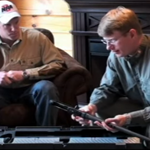
Dozens of wildfires are currently roaring their way through the forests and brushlands of the American West, and thousands of firefighters—both men and women—are battling the blazes. But what is it like to actually be on the fire line, to breathe the acrid smoke, feel the intense heat of racing orange flames, and silently pray that the wind doesn’t suddenly change direction and trap you in an inescapable inferno?
Someone who knows the answers to those questions firsthand is Tim Snyder of Springfield, Ohio. Having only recently completed a 21-year career in wildlands firefighting, Snyder was deployed west 18 times, fighting more than two dozen fires.
He learned to fight wildfires while working for the Ohio Department of Natural Resources. “The first two or three fires I was sent on in the West was as an ODNR employee,” said Snyder. “Then I started going out on my own, taking vacation leave to do so. We were allowed on the fire line for 14 days before being required to return home. And there are no days off during that time.”
Not surprisingly, Snyder said the job is demanding: 12-hour days with an occasional 18-hour work day. “On a few fires we worked more than 24 hours straight,” he said. For their efforts fire crew members are paid from $10 to $20 per hour, depending upon their level of responsibility, experience and expertise.
Much of the work involves building a fire line, using a shovel and other hand tools to dig and scrape away all the combustible material in a 3-foot-wide swath of ground that stretches for miles. It’s hot, dusty, dirty, back-breaking work, but must be done to stop a raging wildfire. Bulldozers are used wherever possible, but on mountainous or remote terrain where bulldozers cannot operate, fire crews are sent in.
A crew consists of 20 people including a crew boss, possibly a crew-boss trainee, three squad bosses, and finally squads that consist of five or six people. Snyder began as a basic firefighter, then advanced to squad boss. He eventually became an ICT5, a position Snyder calls super-squad boss.
“When most people see the dramatic footage of a forest fire burning on TV they assume that firefighters are directly in front of the flames squirting water at it; but that is not how fires are fought,” he said. “What firefighters do is build a fire line, sometimes miles away from where the main fire is burning. Then we actually start a fire inside that line that burns toward the main fire. Once the two fires meet, there is no longer any fuel remaining and both fires eventually go out.”
At least that’s how things are supposed to work. Snyder and his crew were initiating just such a “burn-out,” as it’s termed, when his most memorable day on the fire line occurred.
“We were working the 2007 Trout Meadows Fire in the Umatilla National Forest in Oregon,” Snyder recalled. “My crew was in a dense forest of spruce and fir trees, some standing 80 to 90 feet tall, and all the trees were covered with Grandfather’s Beard, a lichen that hangs down and looks much like the Spanish moss growing on trees in the South. When flames touch the base of such a tree, the entire tree ignites like a Roman candle; it makes a loud whooshing roar and sends burning embers flying in every direction.
“That particular back fire got so intense that helicopters were making water drops directly behind us and airplanes were flying over spreading a slurry of orange fire retardant. At one point we even got splattered by the retardant, which isn’t safe because the slurry can be very heavy, even breaking off large tree limbs as it falls. So the combined noise of the back fire, with trees igniting and helicopters and airplanes overhead, made things really loud and confusing. It was a day I’ll never forget.” (The photo accompanying this story was taken that particular day; Snyder is the person standing in the lower right corner.)
He and his crew were never trapped by a fire, but Snyder has had to evacuate areas rapidly. “The fire bosses are very cautious,” he said. “And if we were working anywhere close to an active fire we always posted our own crew lookout, as well. In addition, we had a safe zone identified nearby that we could run to in case of emergency. And we always carried what are called ‘baked-potato’ tents, aluminum emergency fire shelters that are just large enough for one person to huddle under and allow the fire to sweep over us.”
Most wildlands firefighters eat and sleep in a fire camp miles from the active fire. Much like a military field base, the camp has shower facilities, a mess tent and portable toilets. “And they send you out daily with a good-sized lunch, because you never know when you’ll get back to camp,” Snyder said.
For instance, if you’re working a fire line and it gets late in the day, you may be instructed to “coyote” for the night, which means finding a safe spot to sleep for a few hours, then get back up and continue to build the line.
To prepare for such a job—either a part-time or full-time career—a potential firefighter needs to be in excellent physical condition. “The ‘pack test’ tends to weed people out,” said Snyder. “It involves walking 3 miles in 45 minutes, which isn’t too difficult for most young people. However, you are also carrying a 45-pound pack on your back as you walk.” In other words, no wimps need apply.
Also helpful to have before applying for such a job is some actual firefighting experience. Snyder recommends volunteering with a local volunteer fire department as a way to start. And if you happen to be attending a natural-resources college or tech school, take a wildlands firefighting course or two if offered.
Asked what made him want to fight wildfires, Snyder had this to say. “I guess initially it was the idea of an adventure,” he said. “It was something I never thought I’d have a chance to do, but suddenly I had the opportunity and knew that if I didn’t take advantage of it I’d probably regret that decision the rest of my life.”
Snyder said, too, that when you head out on a fire for the first time you don’t quite know what to expect, so there is a bit of anxiety. “Firefighting is not for everyone, and some guys and gals work one fire and you never see them again,” he said. “But for other people—and I guess I’m one of them—firefighting gets into your blood and you keep going back when called upon by the Forest Service. The camaraderie of other firefighters is part of the draw, too.
“I’m proud of my career and that I was able to participate for as long as I did,” said Snyder. “But eventually your body begins to let you know that it’s time to quit; firefighting is definitely a young person’s job. I’m thankful for all the various people I met through the years and the wild places I saw. But my ultimate memory is of driving through small western towns and seeing homemade signs that read: Thank you, firefighters! That’s when you knew you were doing something good…something worthwhile.”






































